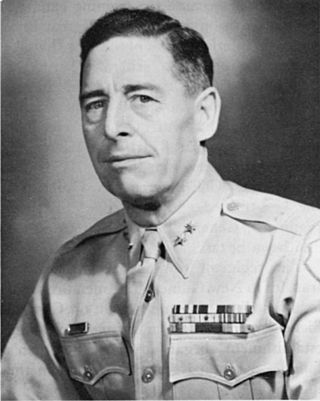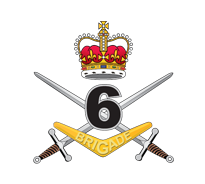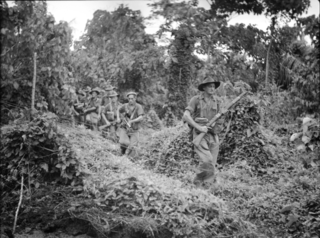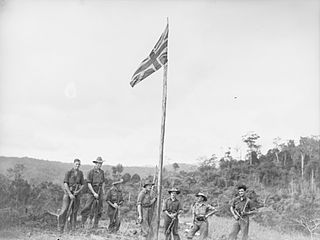
The 41st Infantry Division was an infantry division of the United States Army National Guard composed primarily of units from the Pacific Northwest. The division saw active service in World War I and World War II, receiving the nickname “Jungleers” during the latter.

The United States 32nd Infantry Division was formed from Army National Guard units from Wisconsin and Michigan and fought primarily during World War I and World War II. With roots as the Iron Brigade in the American Civil War, the division's ancestral units came to be referred to as the Iron Jaw Division. During tough combat in France in World War I, it soon acquired from the French the nickname Les Terribles, referring to its fortitude in advancing over terrain others could not. It was the first allied division to pierce the German Hindenburg Line of defense, and the 32nd then adopted its shoulder patch; a line shot through with a red arrow, to signify its tenacity in piercing the enemy line. It then became known as the Red Arrow Division.
The 126th Infantry Regiment is a United States military unit of the Michigan Army National Guard. The 126th was originally an infantry regiment, then was converted into an armoured role, and then was converted to a light cavalry reconnaissance unit, with subordinate units stationed in Cadillac, Wyoming, Dowagiac, and Detroit. It was converted back to an infantry unit in 2016.

The Salamaua–Lae campaign was a series of actions in the New Guinea campaign of World War II. Australian and United States forces sought to capture two major Japanese bases, one in the town of Lae, and another one at Salamaua. The campaign to take the Salamaua and Lae area began after the successful defence of Wau in late January, which was followed up by an Australian advance towards Mubo as the Japanese troops that had attacked Wau withdrew to positions around Mubo. A series of actions followed over the course of several months as the Australian 3rd Division advanced north-east towards Salamaua. After an amphibious landing at Nassau Bay, the Australians were reinforced by a US regimental combat team, which subsequently advanced north up the coast.

The 32nd Infantry Division of the German Army was mobilized on 1 August 1939 for the upcoming invasion of Poland. At that time, it consisted of the usual German infantry division elements: three infantry regiments of three battalions each, one three-battalion regiment of light artillery, one battalion of heavy artillery, a Panzerjäger (anti-tank) Battalion, a reconnaissance (Aufklärungs) Battalion, a Signals Battalion, a Pioneer (Engineer) Battalion, and divisional supply, medical, and administrative units.

Herman John Bottcher was an American soldier born in Germany, who was awarded the rank of captain in two different armies, the International Brigade during the Spanish Civil War and the United States Army during World War II. He was awarded two U.S. Distinguished Service Crosses, the highest U.S. military decoration after the Medal of Honor, for conspicuous bravery and leadership on the field of battle during two separate actions at the Battle of Buna–Gona.
Wanigela is a village along Collingwood Bay, Papua New Guinea. The village is served by Wanigela Airport.
The Kapa Kapa Trail is a steep, little-used mountain trail that stretches from the Kapa Kapa village on the south coast of Papua New Guinea, across the extremely rugged Owen Stanley Range, to the vicinity of Jaure on the north side of the Peninsula. Also known as the Kapa Kapa-Jaure Track, the trail is parallel to but 48 kilometres (30 mi) southeast of the better-known and more accessible Kokoda Track. The 84-mile-long (135 km) Kapa Kapa Track is half again as long as the 135-mile-long (217 km) Kokoda Track. At its highest elevation of 2,700 metres (8,900 ft), it is 510 metres (1,670 ft) higher than the Kokoda Track's highest point. Total ascent and descent is around 17,000 metres (56,000 ft). Because the track is very steep, difficult, and unimproved, it has been hiked by very few non-native individuals.

New Guinea Force was a military command unit for Australian, United States and native troops from the Territories of Papua and New Guinea serving in the New Guinea campaign during World War II. Formed in April 1942, when the Australian First Army was formed from the Australian I Corps after it returned from the Middle East, it was responsible for planning and directing all operations within the territory up until October 1944. General Headquarters Southwest Pacific Area Operational Instruction No.7 of 25 May 1942, issued by Commander-Allied-Forces, General Douglas MacArthur, placed all Australian and US Army, Air Force and Navy Forces in the Port Moresby Area under the control of New Guinea Force. Over the course of its existence, New Guinea Force was commanded by some of the Australian Army's most notable commanders, including Sydney Rowell, Sir Edmund Herring and Sir Leslie Morshead.

The Battle of Sio, fought between December 1943 and March 1944, was the break-out and pursuit phase of General Douglas MacArthur's Huon Peninsula campaign, part of the New Guinea campaign of World War II.

Edwin Forrest Harding commanded the 32nd Infantry Division at the beginning of World War II. He graduated 74th among his classmates from the United States Military Academy in 1909, who included John C. H. Lee (12), Jacob L. Devers (39), George S. Patton (46), Horace H. Fuller (59), Robert L. Eichelberger (68), and William H. Simpson (101). His first field command, the 32nd division was the first American unit, after the Battle for Guadalcanal, to engage in offensive operations in the Pacific Theater of Operations. The 32nd was understrength, ill-trained, poorly equipped, and thrust into its first battle against seasoned Japanese units. The unit finally logged a total of 654 days of combat during World War II, more than any other U.S. Army division. They were among the first to enter the war and were still engaging attacking Japanese after the Armistice was declared.

The 6th Combat Support Brigade is an Australian Army brigade. First formed in 1912 as a Militia formation to provide training under the compulsory training scheme, the brigade was re-raised during the First World War as an infantry unit of the all volunteer Australian Imperial Force. It subsequently served at Gallipoli and in France and Belgium on the Western Front. In the 1920s, as part of a reorganisation of the Australian Army, it became part of the 3rd Military District of the Citizens Military Force, encompassing units from Victoria and South Australia. In 1991, it became part of the Ready Reserve Scheme, based at Enoggera Barracks, in Brisbane, Queensland, before being disbanded in 1996 when the scheme was discontinued. The brigade was re-raised on 1 March 2010 to oversee the Army's command support and intelligence, surveillance, target acquisition and reconnaissance units.
The Lae War Cemetery, established in 1944, is located adjacent to the Botanical Gardens in the centre of the city of Lae, the capital of Morobe Province, in Papua New Guinea. The cemetery is managed by the Commonwealth War Graves Commission.

The Battle of Wide Bay–Open Bay was a battle during the New Britain campaign of the Second World War. Following the arrival of the Australians on New Britain in late 1944, replacing the US garrison on the island, they began a limited offensive against the Japanese forces on the island. Pushing east from the positions previously captured by the US troops earlier in the year, after landing at Jacquinot Bay on the southern coast in November, the Australians began advancing across the island towards the Gazelle Peninsula, where they sought to isolate the numerically superior Japanese garrison. This advance was effected along two axes: Cape Hoskins to Open Bay on the northern coast, and Jacquinot Bay to Wide Bay on the southern. Once the Australians had secured a line across the island between Wide Bay and Open Bay in March and April 1945, the fighting on New Britain died down as the Australians sought to contain the larger Japanese garrison while limiting their own casualties. This situation lasted until the end of the war in August 1945.
II Army Corps was a corps in the German Army during World War II.

RAAF Base Amberley is a Royal Australian Air Force (RAAF) military airbase located 8 km (5.0 mi) southwest of Ipswich, Queensland in Australia and 50 km (31 mi) southwest of Brisbane CBD. It is currently home to No. 1 Squadron, No. 6 Squadron, No. 33 Squadron, No. 35 Squadron and No. 36 Squadron. Amberley is also home to Army units making up the 9th Force Support Battalion. Located on 1,600 hectares, RAAF Amberley is the largest operational base in the RAAF, employing over 5,000 uniformed and civilian personnel. There are a variety of other formations on the base such as training colleges and maintenance areas. Amberley's largest squadron in terms of personnel is No. 382 Expeditionary Combat Support Squadron RAAF (ECSS) providing both garrison and deployed combat support. Amberley was one of only two airfields in Australia that were listed as a Transoceanic Abort (TOA) landing site for the Space Shuttle. Amberley is currently undergoing a A$64 million dollar re-development program. The RAAF has plans to have Amberley operating as its "superbase" with flights of F/A-18F Super Hornets, KC-30A, C-17 Globemaster and the C-27J Spartan.
The 105th Cavalry Regiment is a regiment in the United States Army National Guard.

The Battle of Wareo was fought by Australian and Japanese forces in New Guinea during the Huon Peninsula campaign of World War II in the later part of 1943. Coming after the capture of Sattelberg by the Allies, the battle took place amidst the Australian advance north towards Sio. The Australians committed elements from four infantry brigades from the Australian 9th Division with supporting elements including artillery, engineers and tank support, while the Japanese force consisted primarily of two depleted infantry regiments from the 20th Division, with limited artillery support.

The battle of Buna–Gona was part of the New Guinea campaign in the Pacific Theatre during World War II. It followed the conclusion of the Kokoda Track campaign and lasted from 16 November 1942 until 22 January 1943. The battle was fought by Australian and United States forces against the Japanese beachheads at Buna, Sanananda and Gona. From these, the Japanese had launched an overland attack on Port Moresby. In light of developments in the Solomon Islands campaign, Japanese forces approaching Port Moresby were ordered to withdraw to and secure these bases on the northern coast. Australian forces maintained contact as the Japanese conducted a well-ordered rearguard action. The Allied objective was to eject the Japanese forces from these positions and deny them their further use. The Japanese forces were skillful, well prepared and resolute in their defence. They had developed a strong network of well-concealed defences.
The 120th Field Artillery Regiment is a field artillery regiment of the Wisconsin Army National Guard.












